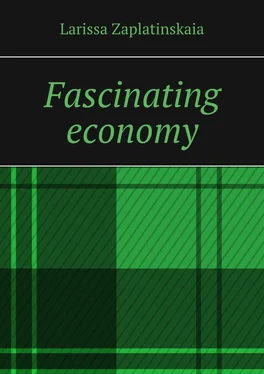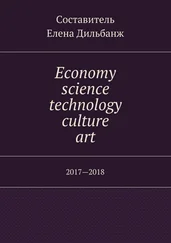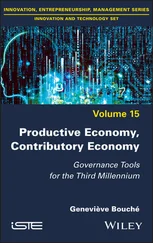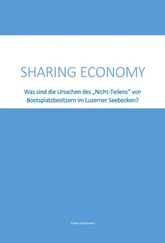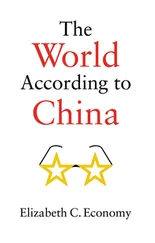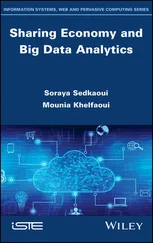Larissa Zaplatinskaia - Fascinating economy
Здесь есть возможность читать онлайн «Larissa Zaplatinskaia - Fascinating economy» — ознакомительный отрывок электронной книги совершенно бесплатно, а после прочтения отрывка купить полную версию. В некоторых случаях можно слушать аудио, скачать через торрент в формате fb2 и присутствует краткое содержание. ISBN: , Жанр: popular_business, на английском языке. Описание произведения, (предисловие) а так же отзывы посетителей доступны на портале библиотеки ЛибКат.
- Название:Fascinating economy
- Автор:
- Жанр:
- Год:неизвестен
- ISBN:9785005199331
- Рейтинг книги:3 / 5. Голосов: 1
-
Избранное:Добавить в избранное
- Отзывы:
-
Ваша оценка:
- 60
- 1
- 2
- 3
- 4
- 5
Fascinating economy: краткое содержание, описание и аннотация
Предлагаем к чтению аннотацию, описание, краткое содержание или предисловие (зависит от того, что написал сам автор книги «Fascinating economy»). Если вы не нашли необходимую информацию о книге — напишите в комментариях, мы постараемся отыскать её.
Fascinating economy — читать онлайн ознакомительный отрывок
Ниже представлен текст книги, разбитый по страницам. Система сохранения места последней прочитанной страницы, позволяет с удобством читать онлайн бесплатно книгу «Fascinating economy», без необходимости каждый раз заново искать на чём Вы остановились. Поставьте закладку, и сможете в любой момент перейти на страницу, на которой закончили чтение.
Интервал:
Закладка:
Since resources are not unlimited everyone has to make tough decisions about what to do with the resources available. One big question that needs to be addressed in any economy is this: What is to be produced?
Because of scarcity, deciding what is to be produced involves also deciding what not to produce.
Remember your bag of flour? You can allocate the flour for making bread for sandwiches. But what if it is your friend’s birthday? If you use the flour for bread, you cannot make a birthday cake. Before you start producing something, you have to decide what to produce.
Allocating resources often involves deciding to produce one thing instead of another.
Getting Organized
Once it is decided what will be produced, there are still more questions to answer. It takes organization to produce and distribute goods and services.
There are all kinds of ways to organize production. There could be factories, offices of varying sizes, or people working at home. There could be different people who specialize in different jobs, or everyone could take turns doing all the different jobs. Production might go on 24 hours a day, seven days a week, or it could be kept to certain working hours.
This is just a short list of the different options. There are many methods of organizing production. How do people decide on the best way to organize production? The economic goals people have will affect how this question is answered. This can again lead to conflict.
The goal of efficiency requires a form of organization that has as little waste as possible. One good way of eliminating waste is to have different workers specialize in different jobs. But if equity is the goal, specialization might not be the way to go. When you divide up production into different tasks, some of the tasks might be harder than others. Equity could mean giving each of these workers a chance to do the easier, cleaner job. But what if freedom is your main economic goal? In this case, production would have to be organized to give workers different choices, and workers would have the freedom to decide what jobs to take.
Who Gets What and Where?
The questions do not stop once decisions about production have been made. You saw that goods often need to be transported from where they are made to where they are used. This is distribution. There is more to distribution than just transportation, however.
Getting goods to the people who use them means making decisions about who gets what. Because of scarcity, some people will not always get what they want. So, the game of economics involves answering a third question: How are goods and services to be distributed?
In other words, how shall we decide who gets what?
If you want equity or security, producers probably need to be told what to produce. Their choices could end up being incompatible with those goals. The government can make sure that everyone is secure, or that goods and services are distributed fairly. But when the government decides how goods and services are distributed, that takes away free choice. Producers are told what to produce and where to send it. A different way to organize distribution is not to organize it at all, to leave it up to people’s free choices to decide what gets produced and how goods and services are distributed. This might result in an unfair distribution, or one that leaves some people insecure, but it would not involve the government telling people what to do.
A Variety of Resources
Organizing an economic system involves making decisions about what is going to be produced and how it should be distributed. That takes care of most of the game of economics.
Still, there is one final question to be answered: What is the most effective allocation of resources?
There are all kinds of resources that go into production and distribution. Remember all the resources needed to make a birthday cake? There are a lot of them: an oven, a timer, ingredients, utensils, time, knowledge, and effort.
Production and distribution usually involve a long list with very different types of resources. The flour needed for the batter is a different type of resource than the oven needed to bake the batter, or the time needed for the whole process.
Deciding how to allocate resources means you have to pay attention to where the different resources come from.
It takes many different resources to make a cake.
The Factors of Production
The types of resources needed for production are known as the factors of production. There are three different factors of production: land (in economics, the term land refers to any natural resource on, under, or over the land), labor, and capital.
Land is useful for making things. Fields are used to grow food, and water or wind can be used to produce energy. And land is not just what you see on the surface of the Earth. It also includes things that can be found underground. Things like coal and iron – even steam and water come from underground. These natural resources are all useful for producing things.
Some goods spring directly from the Earth, but it takes some work on the part of humans to make all goods. Even a wild blackberry has to be picked by someone before it can be eaten. All production requires a human touch. Labor is the work that humans do to take natural resources and turn them into useful products. Sometimes the labor is physical. Sometimes the labor involves coming up with ideas. Whatever form labor takes, these human resources are just as necessary as natural resources.
Capital is the final type of resource needed for production. Capital resources are goods that have been produced by humans to make more goods. Capital includes machines like bulldozers and cement trucks. It also includes buildings like factories and other structures such as dams and oil wells.
The term capital also refers to the money used to pay for other resources. Like other forms of capital, money has been created by humans to help with the process of production.
You can see that playing the game of economics involves answering a lot of different questions. There are four fundamental questions faced by people in all economic systems.
The way these four questions are answered tells you a lot about the way decisions are made in different economic systems. When these questions are answered in different ways, you end up playing different games.
Another major element in economics is the concept of supply and demand. The fundamentals of supply and demand change depending on what type of economic system you are dealing with, however, so this concept cannot be included in the fundamental questions of economics, in general.
The Four Fundamental Questions
1. What is to be produced?
2. How is production to be organized?
3. How are goods and services to be distributed?
4. What is the most effective allocation of resources?
You have seen that there are different economic goals that can be pursued: efficiency, growth, security, equity, and freedom. It can be difficult to decide among them.
Individual people are not the only ones who choose economic goals. Entire societies also make the same choices. If it is hard enough to choose for yourself, imagine how hard it is for a whole society to agree on its economic goals! To make this decision, it helps to understand the different results that occur from pursuing different goals.
For example, what would the game look like if everyone agreed that freedom was the most important goal? To answer this, you can look at how a society that values freedom would answer the four fundamental questions of economics. This tells you what a free-market system looks like.
The free-market system, sometimes referred to as capitalism, is one of the most common economic systems on Earth. Examine how it works.
Читать дальшеИнтервал:
Закладка:
Похожие книги на «Fascinating economy»
Представляем Вашему вниманию похожие книги на «Fascinating economy» списком для выбора. Мы отобрали схожую по названию и смыслу литературу в надежде предоставить читателям больше вариантов отыскать новые, интересные, ещё непрочитанные произведения.
Обсуждение, отзывы о книге «Fascinating economy» и просто собственные мнения читателей. Оставьте ваши комментарии, напишите, что Вы думаете о произведении, его смысле или главных героях. Укажите что конкретно понравилось, а что нет, и почему Вы так считаете.
